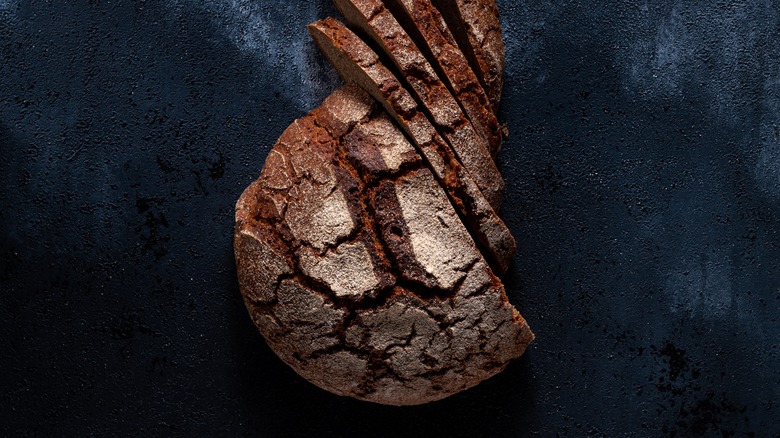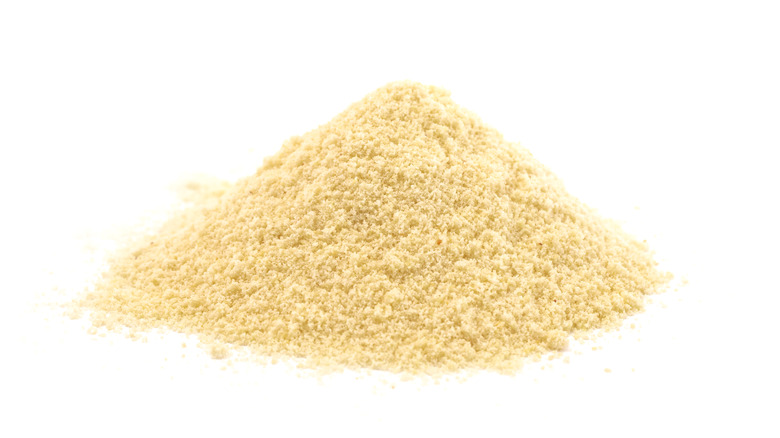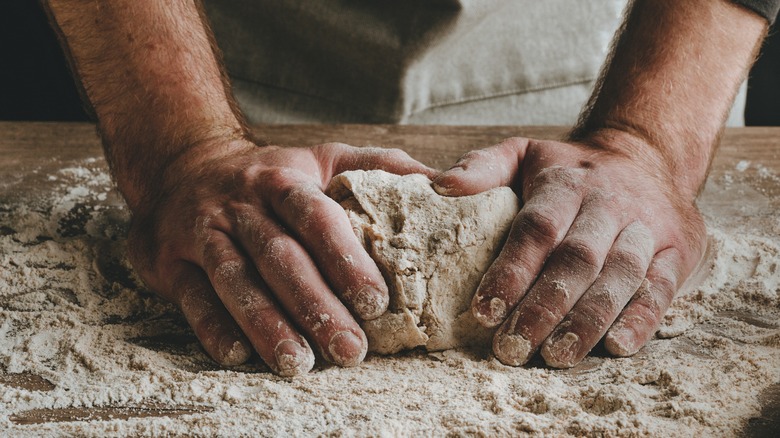The Bark Bread That Resulted From A Widespread Scandinavian Famine
History is littered with hardship, but more often than not, we focus on human-caused disasters such as war, slavery, and religious conflict rather than focus on how nature might have shaped us and our habits. There are a few popular exceptions, of course, such as the Irish potato famine, but when it comes to how famine, in general, changed how and what we eat, many of us would be none the wiser.
Famine (a significant lack of food that leads to malnourishment and starvation) influences many, if not all, parts of society, but one of the things it forces people to go look for alternative food sources. You see, when hunger eats away at your body, you're willing to try anything. According to The Health Board, when traditional crops and livestock begin to fail, our ancestors looked to wild food resources that aren't normally farmed. Kelp was consumed in Ireland during the Great Famine (1845 – 1851), wild grass was eaten by the Russians when they went to war, and in Scandinavia, when times were tough, people turned to trees.
History of pettuleipä
When we think of using trees as food, oftentimes we concern ourselves with the fruits and nuts they bare, the syrups they produce, or the lumber they supply for cooking. It is significantly less common to hear about people eating tree bark itself for a meal, but that's exactly what the Indigenous Samí people native to northern Scandinavia have been doing for centuries! Atlas Obscura tells us that the Samí have used the inner bark (aka the phloem) of pine and birch trees as a source of nutrition. It has long been one of their staple food items, and it is their knowledge that Nordic farmers and citizens used during times of famine to stay alive. People would strip the bark off of trees, dry and roast the wood, and grind it into flour to make bark break which, in Finland, they call pettuleipä.
According to Lund University's publication on "Famines in the Nordic Country," the tree bark wasn't the only natural foodstuff people would turn to during famine. Things like flower buds, nettles, leaves, and hay were all desperately devoured, though they offered little relief from hunger and unfortunately malnutrition killed an unfathomable amount of people throughout history. Researchers confirm that people throughout Sweden and Finland, not just the Samí people, took to eating bark by the mid-17th century due to persistent food scarcity; it was during this time that pettuleipä became popular.
Ingredients of Pettuleipä
Pettuleipä is made from the wood of a pine tree, though the Samí people also used wood from native spruce and birch trees as well. UMP Biofore Beyond Fossils describes the process of making the bark flour for this bread. First, the outer bark is removed from the tree to easily access the softer, inner part of the plant. This bark is then harvested in strips, dried, and ground into what we would consider a flour, "pettu". People would then use pettu in place of flour in their recipes or simply eat the bark itself.
Practical Self Reliance explains that the Samí would traditionally mix the bark with reindeer milk (the Indigenous northern communities of Scandinavia have herded reindeer for thousands of years) though unlike the people residing in Southern Scandinavia, the Samí people harvested both the inner and outer the bark of the trees regularly, not only in times of famine. Birch bark in particular was considered especially valuable and offered some nutrition. The pine bark often used to make pettuleipä today may contain some potential health-benefiting properties such as antimicrobials and antioxidants. In JSTOR's abstract on "Sami Resource Utilization and Site Selection: Historical Harvesting of Inner Bark in Northern Sweden," the harvesting of bark from native trees leaves a mark. The evidence of pettuleipä-making can still be found in the old forests of Scandinavia. Nature bears the scars of this once-necessary harvest and researchers can study the forest to discover how often and how much the inner bark was harvested over the centuries.
How Pettuleipä is made
Ämän Leipä Oy is one of the rare bakeries in the world that still makes pettuleipä. The family-run business is located in Kainuu, Suomussalmi which is a municipality in Finland. The bakery has been running since 1977 and now boasts gluten-free goods as well as bread made from pettu flour (aka pine bark flour). Pettuleipä is considered an authentic and traditional food through the Scandinavian subregion, and New Life on Homestead, says that it tastes a touch sweet and green when baked with bark taken from a living tree. After drying and grinding, you can use your pettu flour to make bread, but the bark does not rise like glutinous wheat flour and it also has a harder time clinging together. It is best to use pettu flour not as a sole flour substitute in your recipes, instead the site suggests substituting about one-third of a recipe's flour with bark flour.
Emmymade on Facebook has a video where she makes her own pettuleipä recipe. She begins by using a sourdough starter to give her bread some "puff" from that natural yeast and mixes it with rye flour. The recipe takes a long time to sit with intervals of up to 14 hours in between steps. Pettu is then added slowly to the porridge-like starter along with more rye flour. You can then shape the dough into a traditional, flat ring shape and bake or make it into a loaf.



